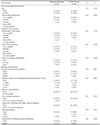References
1. Korean Health Promotion Institute. Tabacco Control Issue Report Seoul: Korean Health Promotion Institute; 2016.
2. Hahn EJ, Rayens MK, Chaloupka FJ, Okoli CT, Yang J. Projected smoking-related death among U.S. youth: a 2000 update Chicago: University of Illinois; 2002.
3. Kim HO, Jeon MS. The relationship between smoking, drinking and the mental health in adolescents. J Korean Public Health Nurs 2007;21(2):217–229.
4. Centers for Disease Control and Prevention (CDC). Current cigarette smoking among adults - United States, 2011. MMWR Morb Mortal Wkly Rep 2012;61(44):889–894.
5. Hwang MS. A meta-analysis of adolescent psychosocial smoking prevention programs in the United States - identifying factors associated with program effectiveness. Korean J Health Educ Promot 2007;24(5):1–21.
6. Choi JM. Development of a predictive model of adolescent smoking [dissertation] Seoul: Seoul National University; 2000. Korean.
7. Fishbein M, Ajzen I. Belief, attitude, intention and behavior: an introduction to theory and research Addison-Wesley; 1975. p. 578.
8. Kim YH. A study on research trends in the creative experience activities for elementary school. J Educ Innov Res 2015;25(3):45–65.
9. Do J, Sung J. The effects of youth activity on sociality development. J Adolesc Welf 2013;15(2):145–173.
10. Ussher MH, Owen CG, Cook DG, Whincup PH. The relationship between physical activity, sedentary behaviour and psychological wellbeing among adolescents. Soc Psychiatry Psychiatr Epidemiol 2007;42(10):851–856.
11. Ahmed NU, Ahmed NS, Bennett CR, Hinds JE. Impact of a drug abuse resistance education (D.A.R.E) program in preventing the initiation of cigarette smoking in fifth- and sixth-grade students. J Natl Med Assoc 2002;94(4):249–256.
12. Kim MH, Cho CM, Chon MY. Effects of a smoking prevention program on primary school students. Korean J Child Health Nurs 2005;11(1):63–71.
13. Paek KS. Effects of a smoking prevention education on primary school students. J Korean Acad Community Health Nurs 2006;17(2):273–282.
14. An HS, Park IH. The effect of smoking prevention education program based on activities with elementary school students on their knowledge and attitude toward smoking and smoking refusal self-efficacy. J Learn Cent Curric Instr 2016;16(5):465–486.
15. Korea Centers for Disease Control & Prevention (KCDC). Korea Youth Risk Behavior Web-Based Survey [Internet] Cheongju: KCDC; 2017. Accessed May 16, 2017. Available from:
https://www.cdc.go.kr/yhs/home.jsp.
17. Seo YS, Kim YI. Factors affecting smoking middle school students' intention to quit smoking: on the basis of the ASE model. J Korean Acad Community Health Nurs 2013;24(4):471–479.
18. Choo J, Kim EK. Application of the ASE model to the assertive behavior of non-smoking college students under secondhand smoke exposure. J Korean Acad Community Health Nurs 2011;22(1):1–10.
19. Bandura A. Self-efficacy mechanism in human agency. Am Psychol 1982;37(2):122–147.
20. Prochaska JO, DiClemente CC. Transtheoretical therapy: toward a more integrative model of change. Psychol Psychother 1982;19(3):276–288.
21. Park SW. Factors related with the intention of smoking abstinence among elementary students in a large city. J Korean Soc Sch Health 2009;22(1):49–59.
22. Kim AS, Park JH, Hwang EK, Kim SM, Choi SH, Shin EH, et al. Elementary School Together Health 1st edth ed. Seoul: Education of genius; 2009. p. 160.
23. Woo OY, Kim MK, Kim YS, Park JS, Shin MS, Yoo NS, et al. Elementary School Together Health 2nd edth ed. Seoul: YBM; 2011. p. 160.
24. Superintendent of Gyeonggi-do Education. Join us FUN FUN Experience-based Smoking Prevention Program 1st edth ed. Suwon: Gyeonggi-do Office of Education Physical and Health Education & Gyeonggi-do Elementary School Health Education Study Society; 2016. p. 97.
25. Korea Health Promotion Institute. SENSE Elementary school Smoking Prevention Standard education Program 1st edth ed. Seoul: Ministry of Health and Welfare & Korea Health Promotion Institute National Anti-smoking Center; 2016. p. 85.
26. Lee JS, Kim HK. Meta-analysis of effectiveness of smoking prevention program for elementary school students. Korean J Health Educ Promot 2017;34(4):99–110.
27. Jackson C, Dickinson D. Cigarette consumption during childhood and persistence of smoking through adolescence. Arch Pediatr Adolesc Med 2004;158(11):1050–1056.
28. Park SW, Kim JY. Smoking experience and related factors among elementary students in a metropolitan city in korean by design-based analysis. J Korean Soc Matern Child Health 2007;11(2):197–210.


